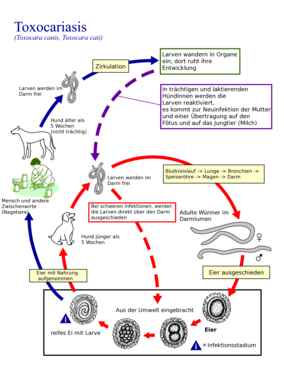Toxocariasis
| Classification according to ICD-10 | |
|---|---|
| B83.0 | Larva migrans visceralis - Toxokariasis |
| ICD-10 online (WHO version 2019) | |
The toxocariasis is a zoonotic disease of man as accidental hosts, by the Hundespulwurm Toxocara canis or Katzenspulwurm Toxocara mystax (= T. cata ) is triggered. Infection occurs through oral ingestion of worm eggs, which come from the feces of infected dogs and cats and, depending on the temperature and humidity, have to mature in the environment for three to four weeks in order to be infectious. In particular, the internal organs ( visceral larva migrans ) or the eyes ( ocular larva migrans ) can be affected.
Epidemiology
Toxocara canis and Toxocara mystax are common in dogs and cats worldwide. Almost all puppies are infected. Sandboxes are particularly noteworthy as a source of infection for children. Wheelchair users are more likely to be affected because they pick up the eggs with their hands. In addition, dogs can wear roundworm eggs by their paws and dog owners who are away from footpaths with their shoes in living areas.
Course of disease
After ingesting the eggs, the larvae hatch in the human small intestine and penetrate the mucous membrane . They then reach various organs through haematogenic (via the blood vessels ) or lymphogenic (via the lymphatic vessels ) spread. In the organs, they destroy cells and tissue and trigger an inflammatory response in the host. Symptoms only develop with mass infestation. The Toxocara larvae mainly migrate to the eye and brain, but in principle they can attack any organ. The incubation period is usually weeks to months. Asymptomatic or dormant infections are common and can develop into visceral or ocular larva migrans even after ten years. Common differential diagnoses of ocular larva migrans are toxoplasmosis , Coats disease , macular degeneration , hemorrhagic chorioretinitis, and retinoblastoma .
diagnosis
Since the development cycle is not complete in humans, no adult worms enter the intestine. This means that no worm eggs, larvae or adult worms can be detected in the stool. The infection can be detected using ELISA . In patients with symptomatic toxocariasis, the IgE levels are significantly increased. Furthermore, there is a eosinophilia and leukocytosis .
prevention
To avoid infection in humans, dogs and cats should be dewormed regularly , especially with young animals due to the high level of contamination . Hands should also be washed after contact with animals, as the eggs also adhere to the fur. The contamination of sandboxes with dog or cat droppings should be avoided or at least the sand should be changed regularly.
therapy
Treatment is with albendazole , mebendazole , thiabendazole or diethylcarbamazine . The use of anthelmintics is controversial due to the massive release of decay products from the larvae as a result of therapy . Corticosteroids are added in cases of ocular or CNS involvement. In the case of ocular larva migrans, photoagglutination of the larvae using a laser can also be carried out.
See also
literature
- H. Hof, R. Dörries: Medical microbiology. 3rd, completely revised and expanded edition. Thieme, Stuttgart, 2005, ISBN 3-13-125313-4 .
- W.Kiehl et al .: Profiles of rare and imported infectious diseases. Robert Koch Institute, Berlin 2011, ISBN 978-3-89606-240-6 .
Individual evidence
- ↑ OA Panova and AV Khrustalev: Dog walking brings Toxocara eggs to people's homes. In: Vet. Parasitol. Volume 262, 2018, pp. 16-19.
- ↑ Edith Maria Plumhoff: Diagnosis of toxocariasis based on anamnestic, clinical and serological parameters. Dissertation, Würzburg 2007.
- ↑ M. Niederig et al .: Profiles of rare and imported infectious diseases. Berlin 2006.
- ^ Marianne Abele-Horn: Antimicrobial Therapy. Decision support for the treatment and prophylaxis of infectious diseases. With the collaboration of Werner Heinz, Hartwig Klinker, Johann Schurz and August Stich, 2nd, revised and expanded edition. Peter Wiehl, Marburg 2009, ISBN 978-3-927219-14-4 , p. 294.
